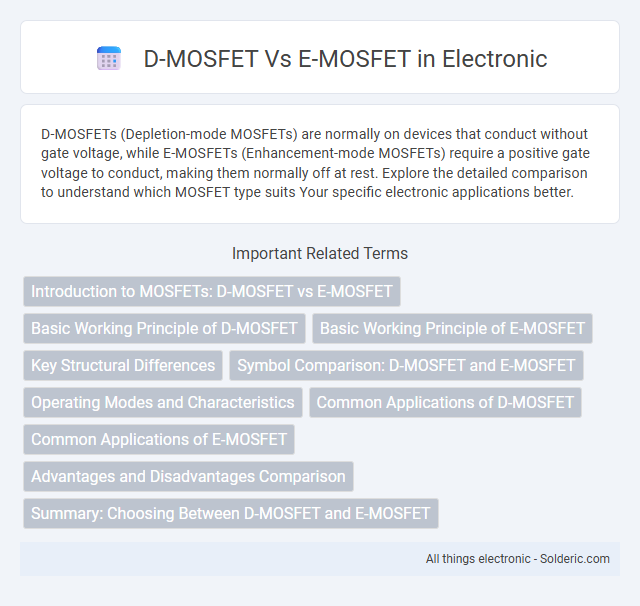D-MOSFETs (Depletion-mode MOSFETs) are normally on devices that conduct without gate voltage, while E-MOSFETs (Enhancement-mode MOSFETs) require a positive gate voltage to conduct, making them normally off at rest. Explore the detailed comparison to understand which MOSFET type suits Your specific electronic applications better.
Comparison Table
| Feature | D-MOSFET (Depletion MOSFET) | E-MOSFET (Enhancement MOSFET) |
|---|---|---|
| Operation Mode | Normally ON (Conducting without gate voltage) | Normally OFF (Non-conducting without gate voltage) |
| Gate Voltage Effect | Negative gate voltage reduces current; positive increases it | Positive gate voltage required to induce channel and conduct |
| Channel Formation | Channel exists at zero gate bias | No channel at zero bias; formed by gate voltage |
| Symbol | Line inside channel indicating existing channel | No line inside channel (indicates enhancement) |
| Application | Amplifiers, analog switches | Digital circuits, switching devices |
| Threshold Voltage (Vth) | Negative or zero | Positive |
| Device Type | Depletion-mode transistor | Enhancement-mode transistor |
Introduction to MOSFETs: D-MOSFET vs E-MOSFET
D-MOSFETs (Depletion-mode MOSFETs) operate with a conductive channel at zero gate voltage, allowing current flow until a reverse voltage depletes carriers, suitable for normally-on switching applications. E-MOSFETs (Enhancement-mode MOSFETs) require a positive gate voltage to induce a conductive channel, commonly used in digital circuits due to their normally-off state at zero gate voltage. These fundamental differences in operation influence their switching behavior, threshold voltage, and power efficiency in electronic devices.
Basic Working Principle of D-MOSFET
D-MOSFET, or Depletion-mode MOSFET, operates by allowing current flow between the source and drain even when the gate-to-source voltage is zero, due to a conductive channel present by default. Applying a negative gate voltage depletes this channel, reducing current flow and effectively turning the device off. Your understanding of this fundamental principle highlights the key difference from E-MOSFETs, which require a positive gate voltage to create a conductive channel.
Basic Working Principle of E-MOSFET
E-MOSFET, or Enhancement MOSFET, operates by creating a conductive channel between the source and drain terminals through the application of a positive gate voltage, which enhances electron flow in an n-channel device. Unlike D-MOSFET (Depletion MOSFET), which starts with a conductive channel that can be depleted by gate voltage, E-MOSFET devices require this voltage to induce a channel, making them normally off at zero gate bias. Understanding the basic working principle of E-MOSFET is crucial for designing circuits where you want controlled conduction, such as in switching applications for power management in your electronic systems.
Key Structural Differences
D-MOSFETs (Depletion-mode MOSFETs) feature a channel that is naturally conductive at zero gate bias, relying on a doped channel to maintain current flow, whereas E-MOSFETs (Enhancement-mode MOSFETs) possess no channel at zero gate bias and require a positive gate voltage to induce conduction. The D-MOSFET structure includes a doped channel region between the source and drain, allowing current flow without gate voltage, while the E-MOSFET has a lightly doped substrate that forms a channel only when an electric field is applied. These structural differences significantly impact their threshold voltages and typical applications in analog and digital circuits.
Symbol Comparison: D-MOSFET and E-MOSFET
The symbol for a D-MOSFET (Depletion MOSFET) typically features a channel line between the source and drain with a gate separated by an insulating layer, often depicted with a solid line indicating a normally-on device. In contrast, the E-MOSFET (Enhancement MOSFET) symbol shows a broken or dashed channel line, representing a normally-off device requiring gate voltage to induce a conductive channel. These graphical distinctions clearly convey the operational modes and biasing requirements essential for circuit design and analysis.
Operating Modes and Characteristics
D-MOSFETs (Depletion-mode MOSFETs) operate with a normally-on channel, conducting at zero gate-to-source voltage, which requires a negative gate bias to turn off, while E-MOSFETs (Enhancement-mode MOSFETs) have a normally-off channel and require a positive gate voltage to create a conduction path. D-MOSFETs exhibit negative threshold voltages and symmetrical conduction characteristics, allowing for operation in both depletion and enhancement modes, whereas E-MOSFETs show positive threshold voltages and primarily function in enhancement mode. These differences impact switching behavior, with E-MOSFETs favored for digital circuits due to low leakage current and high input impedance, while D-MOSFETs are often used in analog applications requiring normally-on devices.
Common Applications of D-MOSFET
D-MOSFETs are commonly used in power electronics for switching applications due to their low on-resistance and high efficiency, making them ideal for DC-DC converters, motor drives, and power amplifiers. Their ruggedness and ability to handle high currents suit automotive electronics and industrial power management systems. Compared to E-MOSFETs, D-MOSFETs offer superior thermal performance and switching speed in demanding environments.
Common Applications of E-MOSFET
E-MOSFETs are widely used in power management applications such as DC-DC converters, motor drivers, and load switches due to their high input impedance and fast switching capabilities. You will often find E-MOSFETs in automotive electronics, battery-powered devices, and RF amplifiers where low gate leakage and high efficiency are critical. Their ability to handle high voltages and currents makes them essential components in modern electronic circuits requiring reliable and efficient switching.
Advantages and Disadvantages Comparison
D-MOSFETs (Depletion-mode MOSFETs) offer the advantage of normally-on operation, allowing current flow without gate voltage, which simplifies circuits requiring fail-safe designs. E-MOSFETs (Enhancement-mode MOSFETs) remain normally off, providing better power efficiency and more precise control in switching applications. You should consider that D-MOSFETs may consume more static power, whereas E-MOSFETs require a positive gate voltage for conduction, impacting their suitability for low-power or digital circuits.
Summary: Choosing Between D-MOSFET and E-MOSFET
D-MOSFETs offer faster switching speeds and lower on-resistance, making them ideal for high-frequency and power-sensitive applications, while E-MOSFETs provide enhanced gate control and better thermal stability suited for precision analog circuits. Selection depends on prioritizing performance metrics like switching efficiency versus linearity and thermal management. Engineers must evaluate application-specific requirements, such as operating voltage and signal integrity, to determine the optimal MOSFET type.
D-MOSFET vs E-MOSFET Infographic

 solderic.com
solderic.com